
Silat Melayu, also known as Seni Persilatan Melayu or simply Silat, is a combative art of self-defence from the Malay world, that employs langkah ('steps') and jurus ('movements') to ward off or to strike assaults, either with or without weapons. Silat traced its origin to the early days of Malay civilisation, and has since developed into a fine tradition of physical and spiritual training that embodies aspects of traditional Malay attire, performing art and adat. The philosophical foundation of modern Malay Silat is largely based on the Islamic spirituality. Its moves and shapes are rooted from the basis of Silat movements called Bunga Silat, and Silat performances are normally accompanied with Malay drum assembles.
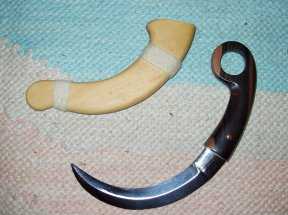
The karambit or kerambit, kurambik or karambiak is a small Indonesian curved knife resembling a claw from Minangkabau people of West Sumatra. The karambit is one of the weapons commonly used in pencak silat and Filipino martial arts.

The culture of Indonesia has been shaped by long interaction between original indigenous customs and multiple foreign influences. Indonesia is centrally-located along ancient trading routes between the Far East, South Asia and the Middle East, resulting in many cultural practices being strongly influenced by a multitude of religions, including Buddhism, Christianity, Confucianism, Hinduism, and Islam, all strong in the major trading cities. The result is a complex cultural mixture, often different from the original indigenous cultures.

Pencak silat is an umbrella term for a class of related Indonesian martial arts. In neighbouring countries, the term usually refers to professional competitive silat. It is a full-body fighting form incorporating strikes, grappling and throwing in addition to weaponry. Every part of the body is used and subject to attack. Pencak silat was practiced not only for physical defense but also for psychological ends. There are hundreds of different Pencak silat styles and schools which tend to focus either on strikes, joint manipulation, weaponry, or some combination thereof.
The Liu Seong System is one of the many styles of Kuntao, which are hybrid martial arts systems derived from the cultures of Chinese Indonesia. The Liu Seong system was brought to America, from Indonesia, by Willem A. Reeders (1917-1990).
Seni Gayong is a style of silat from Malaysia. It was the first martial arts association to be registered in the country, and is now the biggest and most internationally known Malaysian silat discipline. Gayong is overseen by the Pertubuhan Silat Seni Gayong Malaysia (PSSGM) or the Malaysian Silat Seni Gayong Organisation. This organisation is currently led by Dato' Ismail Jantan. While it is most popular in Malaysia and Singapore, there are also branches in Vietnam, Australia, France, Kuwait, Tunisia, Britain, and the United States.

Silat is the collective term for a class of indigenous martial arts from the Nusantara and surrounding geo-cultural areas of Southeast Asia. It is traditionally practised in Brunei, Indonesia, Malaysia, Singapore, Southern Thailand, Southern Philippines and Southern Vietnam. There are hundreds of different styles and schools which tend to focus either on strikes, joint manipulation, weaponry, or some combination thereof.

Bakti Negara is a style of pencak silat from Bali. It is firmly rooted in old Balinese Hinduism and philosophies of Indonesia. The name means "national devotion", from the Sanskrit words bhakti (devotion) and nagara (country). It is the most widely practiced martial art in Bali and the most well-known style of Balinese silat, to the point that the system is commonly referred to simply as pencak Bali or kuntao Bali.

The International Pencak Silat Federation (IPSF) or PERSILAT, which was founded in Jakarta on 11 March 1980, is the only international Pencak Silat organization in the world. The International Pencak Silat Federation (IPSF) is the largest international governing body of competitive pencak silat with 66 member countries. IPSF is the only pencak silat organization recognised by the Olympic Council of Asia and has more than five million members. The IPSF organizes the Junior and Senior World Pencak Silat Championships, which are each held every other year. The President of the IPSF is Prabowo Subianto, and the headquarters are located in TMII, Jakarta, Indonesia.
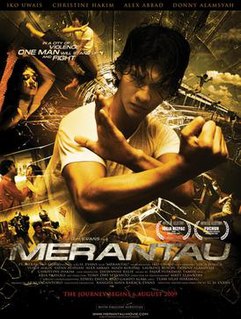
Merantau, released in some countries as Merantau Warrior, is a 2009 Indonesian martial arts action film written, directed and edited by Gareth Huw Evans, and starring Iko Uwais. The film, which marks Uwais' debut as an actor, is the first collaboration between director Evans and star Uwais. It also marks the acting debut of Yayan Ruhian, both of whom Evans met while shooting for a documentary in Indonesia which became his introduction to the Pencak Silat martial art.
Silat Patani is a style of silat originating in the Pattani kingdom, now a state of Thailand. It is primarily practiced in northern Malaysia and southern Thailand. The art is also known as silat tua because tradition credits it as the oldest form of silat Melayu. It is sometimes called silat tua Yawi, being the Thai-Malay pronunciation of Jawi in this case referring to the Thai Malay community. These two latter names are increasingly popular among Malaysian practitioners, so as not to acknowledge the Pattani origin of the art.
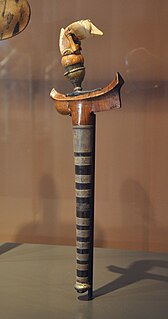
Listed here are the weapons of pencak silat. The most common are the machete, staff, kris, sickle, spear, and kerambit. Because Southeast Asian society was traditionally based around agriculture, many of these weapons were originally farming tools.

Tiger from Tjampa is an Indonesian black and white drama film released in 1953, produced by Perfini, written and directed by D. Djajakusuma. It is still highly regarded today in Indonesia as an early portrayal in a fiction film of aspects of a traditional regional culture. Despite the numerous combat scenes as well as scenes of students practicing pencak silat, Indonesia's traditional form of self-defence, based on the movements of animals and although in the film, the lessons are conducted by a famous master, Tiger from Tjampa was never presented as a martial arts film.
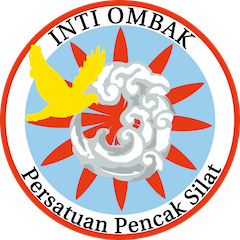
Inti Ombak is a style of pencak silat which blends martial arts descended from the Mataram Kingdom of Central Java with those hailing from the island of Madura. In English it is often abbreviated to IOPS, short for "Inti Ombak Pencak Silat". The Inti Ombak Pencak Silat Union is guided by three caretakers in accordance with the Javanese adage "In the front as a leader, in the middle as a moderator, in the back as an advocate". The current caretakers are Ki Poleng Sudamala of Yogyakarta, Daniel Prasetya of Colorado, and Tjahjadi Tanudjaya of Tengerang. The school's international headquarters are located in Yogyakarta, Indonesia while the US headquarters are in Ault, Colorado.

Sewar refers to a dagger of Indonesian origin, typically carried in a belt and used mainly in Sumatra, Indonesia. The blade is also referred to as Sewah by the Gayo people, Seiva by the Minangkabau people, Siva by the Alas people, and Siwaih by the Acehnese people.
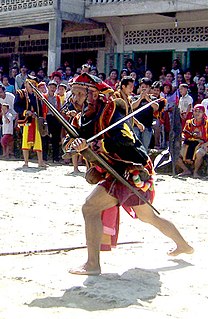
Indonesian martial arts includes a variety of fighting systems native to or developed in the archipelago of Indonesia, both the age-old traditional arts, and the more recently developed hybrid combatives. In the Indonesian language the term bela-diri is used to mean martial art, and in essence the Indonesian fighting arts are meant as one's defence against perceived threat and assault. Other than physical training, they often include spiritual aspects to cultivate inner strength, inner peace and higher psychological ends.

The 2016 ASEAN University Games, officially known as the 18th ASEAN University Games, was a Southeast Asian university multi-sports event held in Singapore. This was the third time Singapore hosted the ASEAN University Games, and its first time since 1994. Previously, Singapore also hosted the 1986 games.
Perguruan Silat Mustika Kwitang, or simply called Kwitang silat, is a Betawinese pencak silat style. It was originally developed in the Kwitang village, which is now part of the Senen subdistrict in Central Jakarta, Indonesia. This style is a hybrid martial arts, developed by combining the local silat with the Chinese-influenced kuntao. The Mustika Kwitang Silat School was founded in 1945 by H. Muhammad Djaelani, who previously studied the martial arts from his own family.

Minangkabau culture is the culture of the Minangkabau ethnic group in Indonesia, part of the Indonesian culture. This culture is one of the two major cultures in the Indonesian archipelago which is very prominent and influential.


















